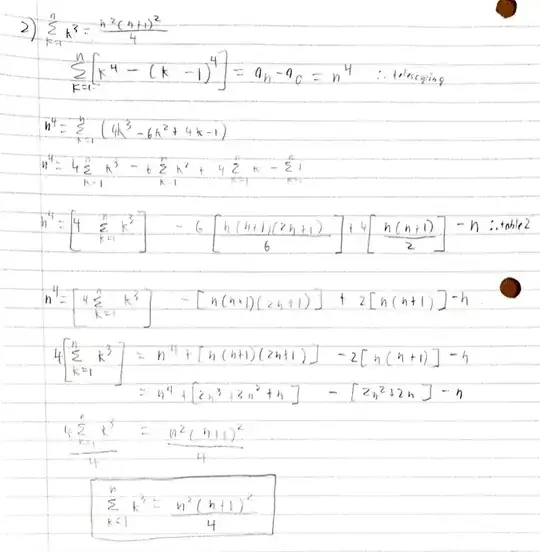The proof reduces to simple polynomial arithmetic if you apply the telescopy theorem below, viz.
$$ \overbrace{\dfrac{n^2(n+1)^2}4}^{\Large F(n)}\, =\, \sum_{k\: =\: 1}^n\:\overbrace{k^3}^{\Large f(k)} \iff \ \color{#c00}{F(1)=f(1)},\,\ \ F(n) - F(n\!-\!1)\ =\ f(n)\ \ {\rm for}\ \ n> 1$$
Checking: the base equation: $\color{#c00}{F(1)} = 1^2 2^2/4 = 1 = 1^3 = \color{#c00}{f(1)}\,$ is true, as is the inductive equation
$$F(n)-F(n-1)\, =\, \dfrac{n^2(n+1)^2}4 - \dfrac{n^2(n-1)^2}4 = \dfrac{n^2(4n)}4 = n^3 = f(n)$$
That completes the proof by the Theorem below.
Theorem $\ $ (Additive Telescopic Induction)
$$ F(n)\ =\, \sum_{\large k\: =\: 1}^{\large n}\:\ f(k)\ \ \iff\ \ \ \color{#c00}{F(1)=f(1)},\,\ \ F(n) - F(n\!-\!1)\ =\ f(n)\ \ {\rm for}\ \ n> 1$$
Proof $\ (\Leftarrow)\ $ The $\,n=1\,$ base case $\,\color{#c00}{F(1) = f(1)} = \sum_{k=1}^1 f(k)\,$ is true, as is the inductive step:
$$\begin{align} F(n\!+\!1)\ &=\ \ \color{#0a0}{F(n)}\ \ +\ f(n\!+\!1)\ \ \ {\rm by\ hypothesis}\\
&=\, \color{#0a0}{\sum_{i=1}^n f(i)} + f(n\!+\!1)\ \ \ {\rm by\ }\color{#0a0}{\rm induction}\\
&=\, \sum_{i=1}^{n+1} f(i)
\end{align}$$
That proves the nontrivial direction $(\Leftarrow)$. The reverse direction is clear. $\ $ QED
Remark $ $ Note that the proof requires no ingenuity whatsoever. Rather it requires only simple computations that are so mechanical that they can be performed by a computer (namely equality testing of polynomials). In particular there is no need to pull your hair out in search of the appropriate inductive step - that is neatly encapsulated once and for all in the Theorem.
See this post and its links for much further discussion of telescopy.
